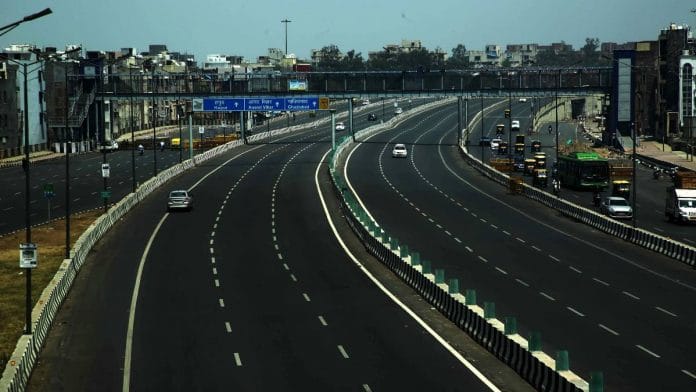New Delhi: With an eye on boosting the post-pandemic recovery of the Indian economy, the Narendra Modi government is likely to continue with its infra push in the 2022-23 budget, especially for the highways sector.
The sector is likely to see an at least 30 per cent jump in capital expenditure in the upcoming Union Budget 2022-23 — to approximately Rs 1.8 lakh crore from Rs 1.18 lakh crore in the ongoing 2021-22 fiscal, ThePrint has learnt.
Finance Minister Nirmala Sitharaman will present the Union Budget on 1 February.
“Unlike other sectors, there is a lot of momentum in the highways sector, with work on a number of big ticket projects including the Delhi-Mumbai and Bengaluru-Chennai expressways already underway. Also, any development of highways will directly result in growth across sectors like cement and steel. The demand for labour also increases,” said a senior official in the Ministry of Road Transport and Highways who didn’t wish to be named.
“Of the total allocation for the sector, the National Highways Authority of India (NHAI) is likely to get Rs 40,000 crore more than last year,” a senior NHAI official told ThePrint on condition of anonymity.
NHAI is the Centre’s main highway building authority.
NHAI debt
According to the NHAI official, while the government is likely to increase the authority’s capex, its “borrowings from external sources will be curtailed”. In the ongoing fiscal, NHAI was allowed to borrow Rs 65,000 crore from the market, the official added.
In recent years, NHAI has been forced to increasingly rely on market borrowings as budget allocations have failed to keep pace amid a massive highway expansion drive. This has resulted in its ballooning debt in recent years.
Union Road Transport Minister Nitin Gadkari informed the Rajya Sabha in a written reply in August 2021 that NHAI’s total borrowings jumped from Rs 74,742 crore outstanding as of March 2017 to Rs 3,06,704 crore in March 2021.
The authority’s debt servicing cost is projected to rise to over Rs 61,000 crore in 2022-23.
Also read: Coming to Central Vista: New PMO in Dholpur sandstone inside Rs 1,200-cr Executive Enclave
Jump fuelled by new greenfield expressways, Bharatmala
The capex rise for the highway sector has been necessitated by a slew of big-ticket projects, including Bharatmala and the greenfield Delhi-Mumbai and Bengaluru-Chennai expressways that are already underway and require a steady flow of funds.
Under the first phase of the Bharatmala project, which has already been approved, NHAI’s target is to develop 27,500 km of highways.
Work on the 1,380-km Delhi-Mumbai expressway is targeted for completion by March 2023. It is being built at an estimated cost of Rs 98,000 crore. Once ready, it will reduce the travel time between Delhi and Mumbai from the current 24 hours to 12 hours.
Highway ministry’s asset monetisation plan on track
To shore up finances to boost the infrastructure sector, the government had launched the National Monetisation Pipeline scheme in August 2021 to monetise assets worth Rs 6 lakh crore between 2021-22 and 2024-25.
The highways ministry was one of the first to monetise its completed public funded road projects.
According to the asset pipeline drawn up by Niti Aayog, the total indicative monetisation value of road assets listed is estimated at Rs 1.6 lakh crore. Spanning 26,700 km, they constitute around 22 per cent of the total National Highways, estimated to be about 1,21,155 km, excluding the network operated by the private sector under build operate transfer (toll)-based public private partnership concessions.
Senior road ministry officials told ThePrint that the ministry’s asset monetisation plan is on track. It is monetising completed stretches of public funded road assets in different tranches through two modes — toll operate transfer (TOT) and infrastructure investment fund (InvIT).
“The bids for the sixth and seventh tranche of TOT road assets will be opened today (28 January),” the NHAI official quoted above said.
So far, NHAI has received Rs 17,000 crore by way of monetising its road assets through TOT.
Also read: Fracture of interstate relations, debt crises top threats for India in WEF survey on global risks






